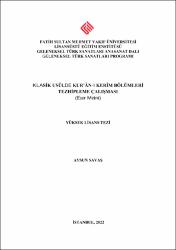Klasik Usûlde Kur’ân-ı Kerîm Bölümleri Tezhipleme Çalışması
Künye
SAVAŞ, Aysun, Klasik Usûlde Kur’ân-ı Kerîm Bölümleri Tezhipleme Çalışması, Fatih Sultan Mehmet Vakıf Üniversitesi Lisansüstü Eğitim Enstitüsü Geleneksel Türk Sanatları Anasanat Dalı Geleneksel Türk Sanatları Programı, Yayımlanmamış Yüksek Lisans Tezi, İstanbul 2022.Özet
Kur’ân-ı Kerîm kitap sanatlarında çok önemli bir yere sahiptir. Kur’ân-ı Kerîm sayfalarının bir araya getirilip iki kapak içinde muhafazasından itibaren, onu en güzel şekilde yazmak ve bezemek İslâm sanatlarında çok önemli bir yere sahip olmuştur. Erken dönemlerden bugüne süregelmiş sanat anlayışı çerçevesinde kutsal kitabımıza verilen değeri yansıtan bir manevîyatla tezhiplenmiştir. Özellikle Osmanlı döneminde mushaf tezyînatı padişahların himayesinde saray nakkaşhânelerinde, bir ekip çalışması dahilinde titizlikle yapılmış ve günümüze ulaşabilen bu eserler Türk tezhip sanatının başlıca kaynaklarını oluşturmuşlardır.
Yazma eserler içinde ilk örneklerinden günümüze Kur’ân-ı Kerîm’ler hat çeşitleri ve sayfa ölçüleriyle farklılıklar göstermektedir. Bu sebeple yapılan bezemelerde yazıya ve sayfa ölçüsüne uygun olarak tasarlanmaktır. Bunun yanında, sancak Kur’ân-ı Kerîm’leri denilen çok küçük ebatta yazılan Kur’ân-ı Kerîm’ler ve dönemin sanat üslûbunu gösteren çok büyük ebatlarda yazılan ve tezhiplenen Kur’ân-ı Kerîm’lerde vardır.
Klasik usûlde Kur’ân-ı Kerîm’de tezhiplenen bölümlerinden zahriye sayfası, serlevha, sûre başı, hâtime sayfası, mushaf gülleri ve kitap kabına örnek olarak altı çalışma yapılmıştır. Çalışmalarda klasik dönem tezhip üslûbu temel alınarak tasarlanıp, desenlerin birbirine uyumu, özgün olması, renk ve boyutlarına dikkat edilerek uygulamaya geçilmiştir. 16. yüzyıl Osmanlı dönemi klasik tezhip sanatı muhtevasında bulunan motifler ve formlardan yola çıkılarak oluşturulan eserlerdir. The Quran has a very important place in book arts. Since the pages of the Quran were brought together and kept in two covers, writing and decorating it in the best way has had a very important place in Islamic arts. It has been illuminated with a spirituality that reflects the value given to our holy book within the framework of the understanding of art that has continued from early times to today. Especially in the Ottoman period, the mushaf decorations were meticulously made in the palace murals under the auspices of the sultans, as a team work, and these works, which have survived to the present day, constituted the main sources of Turkish illumination art.
From the earliest examples of manuscripts to the present day, the Quran differs in calligraphy types and page sizes. For this reason, the decorations are designed in accordance with the text and page size. In addition to this, there are the Qurans written in very small sizes, called the sanjak Quran and the Quran written and illuminated in very large sizes showing the artistic style of the period.
Six studies were carried out as examples for the zahriye page, serlevha, the beginning of the surah, the hâtime page, the mushaf roses and the book binding which are the sections illuminated in the Qurans in the classical style. The works were designed on the basis of the illumination style of the classical period, and the application was started by paying attention to the harmony of the patterns, their originality, color and size. These are the works created by starting from the motifs and forms found in the content of the classical illumination art of the 16th century Ottoman period.



















